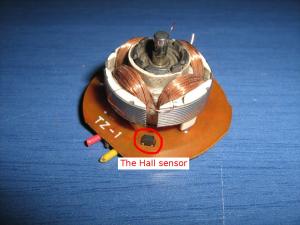Search This Supplers Products:Brushed DC MotorBrushless DC MotorDC Motor ControllerDC Gear MotorDC Brake MotorDC Motors
How the brushless motors work?
publisherHui Han
time2012/05/28
The trick of operation in BLDC motors is the Hall sensor that is attached to the stator. It faces the magnets perpendicularly and can distinguish if the North or South pole is in front of it. The following image shows this Hall senor. The photo is taken from a PC fan (yes, PC fans do have BLDCs!):

If you want to learn how the PC fans operate, follow this link. To better understand the operation of the Hall sensor in respect to the rotor position, i will show you an animation with only 2 magnetic poles and 2 coils. The magnetic poles are both South poles:

The Hall sensor is this little component under the right electromagnet. When it senses the South pole, it keeps the coils turned off. When the sensor senses no magnetic field (or could be also the South pole), then it turns on the coils. The coils have both the same magnetic polarity which is North. So they pull the opposite pole and torque is then created.
If you put a probe to the Hall sensor and watch the signal, then you will discover that during a full rotation of the rotor, the Hall sensor is two times HIGH and two times LOW. The waveform on oscilloscope would be like this one:

Yet another great advantage for the brushless motors. This very signal that is used to control the coils, can be used as is for measuring the speed of the motor! It can also be used to see if the motor is functional or not! Actually, this signal is exactly the one that comes out from the third wire from the PC fans that have 3 (or 4 wires)! These fans do not have any extra circuitry to measure the speed of the motor. They use the signal from the Hall sensor. Each revolution will generate 2 pulses. With a simple frequency measuring circuitry, someone can measure precisely the rpm of the motor
